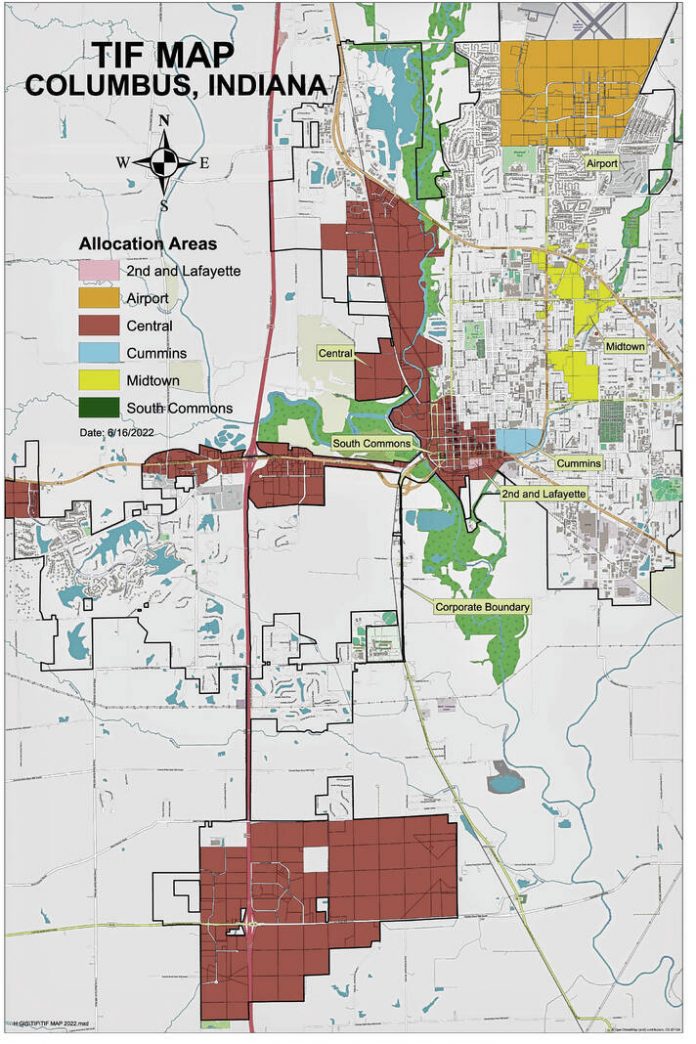Columbus officials are contemplating possible changes to the city’s Tax Increment Financing (TIF) districts, including an expansion of the Central Allocation Area and the creation of a new TIF district downtown.
The Columbus Redevelopment Commission discussed these changes at its June 26 meeting but did not take any action.
A TIF district is a mechanism that allows the commission to siphon off increasing property taxes in a selected area to fund projects intended to benefit the community. There are currently six TIFs:
- Central — covers a wide range of land, including properties on the west side of the city, downtown and the Woodside/Walesboro area
- Airport — covers property in and around Columbus Municipal Airport
- Midtown — covers property in and around NexusPark
- Cummins — covers the Cummins Engine Plant
- South Commons — covers The Cole apartment complex
- Second and Lafayette — covers the land where The Taylor apartment complex is being developed
Most of the proposed changes would affect the Central TIF, which is the largest of the six areas. Redevelopment Director Heather Pope said that the department is proposing to absorb the Cummins and South Commons TIFs back into the Central TIF, as the commission recently finished paying off bonds that were tied to these areas.
They would also like to extend the Central TIF to include additional areas, such as commercial property along the State Street corridor.
“While we were out in that area, we looked at other possible locations that might need redevelopment’s help at some point in time,” said Pope. “We don’t know yet, but here is an industrially zoned piece of property in the old Bartholomew County industrial park. And then if you go up Marr Road here, there is the property south of the AMC Theater and some outparcels that are commercially zoned and have been vacant for years. And so we thought, if it’s ever redeveloped, we can capture that and put that in our TIF district as well.”
They also want to add property in northeast Columbus and the Woodside Northwest Industrial Park that has been annexed and rezoned for industrial use.
Plans also include removing certain parcels near Tipton Lakes Boulevard from the Central TIF.
Pope explained that the land was zoned industrial when the TIF districts were first created in 2005. However, the area has changed since the time and now features uses that do not contribute to the TIF, such as a church, a parcel owned by the Bartholomew Consolidated School Corp. and single-family residential.
Redevelopment officials are also proposing the creation of a new TIF at Sixth and Washington to help fund a proposed mixed-use development in front of the Cummins, Inc parking garage.
Flaherty & Collins Properties, the developer on The Taylor, is proposing to build a five-story apartment building with approximately 50 to 55 units and some first-floor commercial or retail space.
Pope said that the total project cost is estimated at $15.5 million, with a funding gap of about $5.4 to $5.8 million that the commission would cover.
Creating a new TIF in the project area would allow the commission to capture the property’s increment for about 20 to 26 years and recoup its investment, she said.
However, the commission has not yet decided whether to pursue this project and voted at that same meeting to table a resolution to pursue negotiations with the Flaherty & Collins.
When asked how the proposed changes would impact TIF expiration dates, Andrew Lanam with Stifel Financial Corp said that most of the TIF districts are still set to expire at or around 2035, including the Central, Airport, Cummins and Cole allocation areas.
However, more recent additions such as the Second and Lafayette and Midtown TIFs — as well as the proposed new TIF and expansion areas for the Central TIF, if these items are approved — have a different timetable.
According to Pope, the process of amending existing TIFs and creating a new district will require a number of approvals.
“We are wanting to present these as a holistic approach and make the changes all at once,” she said.
The process is as follows:
- The redevelopment commission must approve declaratory resolutions for the various TIF district changes.
- The Columbus Plan Commission must approve the changes.
- Columbus City Council must approve a resolution on the changes.
- The redevelopment commission must approve a confirmatory resolution on the changes.
- Assuming the necessary approvals have been granted, the county auditor and Indiana Department of Local Government Finance will be notified of the changes.
Prior to the commission meeting, Pope shared a timeline with The Republic for the TIF changes and required approvals to facilitate and fund the potential mixed-use project at Sixth and Washington streets. The process was expected to take a couple of months.
The commission’s decision to table the resolution on the mixed-use project will likely push the timeline back somewhat, as the deadline to submit an application for the Columbus Plan Commission’s August meeting is July 10, and the redevelopment commission’s next regularly scheduled meeting isn’t until July 17.





